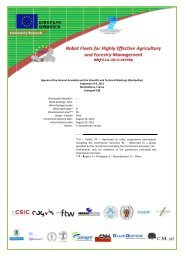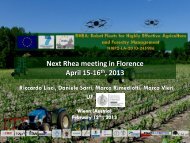1st Workshop BOOK - project RHEA
1st Workshop BOOK - project RHEA
1st Workshop BOOK - project RHEA
Create successful ePaper yourself
Turn your PDF publications into a flip-book with our unique Google optimized e-Paper software.
Effect of flaming with different LPG doses on maize plants<br />
Rooy, 1992). For a common open flamer, LPG consumption, usually varies from 20<br />
to 50 kg ha -1 (Ascard et al., 2007, Peruzzi et al., 2007, Raffaelli et al., 2010, Raffaelli<br />
et al., 2011).<br />
3. Flaming: when and where it can be used<br />
Flaming can be applied:<br />
Before crop planting/emergence on the whole surface (non-selective broadcast<br />
flaming). This method obviously does not require a heat tolerant crop.<br />
After crop emergence:<br />
Non-selective flaming between rows (does not require a heat tolerant crop)<br />
Selective flaming. These methods require heat tolerant crops:<br />
Broadcast flaming (the whole surface area where the crop is located is flamed)<br />
Burners are placed in the rows<br />
Burners are directed at the collar of the crop (“cross flaming”) (Fig. 1)<br />
Non selective flaming before crop planting/emergence is very common in organic<br />
farming with the false seedbed technique, which provides preventive weed control<br />
through seedbank depletion. Weed emergence is stimulated by a delayed seedbed<br />
preparation and the last phase before crop emergence is carried out by flaming.<br />
This does not disturb the soil and the emerging crop and does not stimulate further<br />
weed emergence. This technique is very common in low competitive vegetable<br />
production (i.e. carrot) and is combined with post-emergence mechanical weed<br />
control (Peruzzi et al., 2007, Raffaelli et al., 2010, Raffaelli et al., 2011, Ascard and<br />
van der Weide, 2011).<br />
Non-selective flaming after crop emergence between rows was developed in the<br />
1960s in the USA for weed and insect control in many crops, and for potato haulm<br />
desiccation (Ascard et al., 2007). However this application is not common as a<br />
cultivator/hoe provides less energy-consuming weed control between rows.<br />
Selective broadcast flaming provides weed control on the whole surface where the<br />
crop is located. Heat tolerant crops are required such as maize and onions (Ascard<br />
et al., 2007). Several successful trials were carried out at the University of<br />
Nebraska, in order to investigate the responses of maize, sweet maize, popcorn,<br />
soybean, sorghum, and wheat to broadcast flaming (Ulloa et al., 2011, 2010a,<br />
2010b, 2010c).<br />
Intra-row weed control is challenging for organic farming systems because it is<br />
often very labour intensive, especially in vegetable crops (Fogelberg, 2007, van der<br />
Weide, et al. 2008). This is why in-row flaming plus between row cultivation is a<br />
good option in order to reduce LPG consumption and crop injury compared to<br />
26




